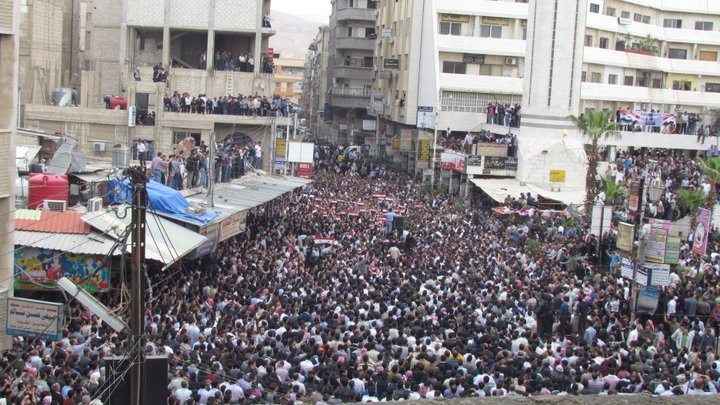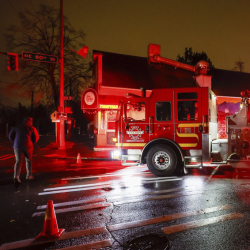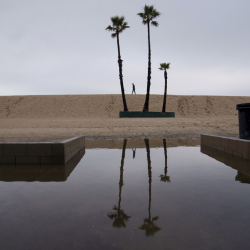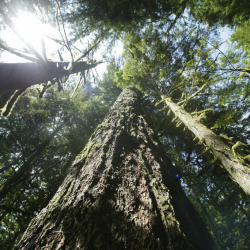 A protest in Damascus earlier this year
A protest in Damascus earlier this year
BEIRUT (AP) -- A Syrian city that was bombed into submission three decades ago after a crushed uprising became a new center for protest and violence Friday, as activists said troops opened fire on a crowd of thousands and killed at least 34. Still, people nationwide poured into the streets in unprecedented numbers, defying the crackdown and a government chokehold on the Internet.
One of the largest protests calling for the ouster of President Bashar Assad was in Hama, where Assad's father killed thousands in 1982 and emerged to rule uncontested, the carnage seared into national memory.
"It is a real massacre," said a witness who took part in Friday's Hama protests and fled the gunfire. "People were running, shouting. We ran up to people's homes and hid there until the gunfire died down," he said.
Friday's protests appeared to be the biggest since the uprising began in mid-March, with people gathering in ever larger numbers in cities and towns across the country, said Rami Abdul-Rahman, director of the Syrian Observatory for Human Rights. Protests also swept through several Damascus suburbs, as well as the capital's central Midan neighborhood, which has seen demonstrations in recent weeks.
The movement has been loosely organized on Facebook pages and increasingly inspired by footage of the crackdown on YouTube and other video sharing sites, but Friday's Internet cuts appeared not to deter participants. Abdul-Rahman said the increase in protesters reflected the lack of trust in any government concessions, including a call for national dialogue.
In Hama, the witness and activists said at least 100,000 people took part in the protest, making it one of the largest in the city since the start of the 11-week uprising. Thirty-four people were killed, said Abdul-Rahman.
Rights groups say more than 1,100 people have been killed nationwide since mid-March.
"Today's protests are a reaction to the so-called overtures by the regime which has lost all credibility. It's the people saying we will not accept this anymore," said Najib al-Ghadban, a U.S.-based Syrian academic and political activist.
Al-Ghadban said the Hama demonstration was especially significant, calling it "a qualitative leap that will encourage others to do the same."
He said most of the protesters were born after the 1982 massacre and do not harbor the same fear as their elders. "They heard about it, which is positive because it makes them more bent on keeping their protest movement peaceful. They don't want a repetition of the massacres."
"You cannot separate what happened in 1982 from what is happening now. It's the same trend, but of course the world has changed so it cannot be on the same scale," he said.
The Syrian Brotherhood, a Sunni Muslim fundamentalist movement, led a violent campaign against the government of Assad's father, late President Hafez Assad, in the late 1970s and early 1980s. Assassinations and bomb attacks killed hundreds as the group attempted to install Islamic rule.
In 1982, Assad's army crushed a Sunni uprising by the Brotherhood in Hama over a three-week period, flattening much of the city and killing 10,000 to 25,000 people, according to Amnesty International estimates.
The eyewitness in Hama said chaos broke out Friday as troops fired tear gas and live ammunition and snipers opened fire on tens of thousands of peaceful protesters who were calling for freedom and Assad's ouster.
"People started running while the dead littered the streets," he said. The activist, who like many involved in the protests requested anonymity to avoid reprisals, said hospitals were calling on people to donate blood.
Syria's state-run TV said three "saboteurs" were killed when police tried to stop them from setting a government building on fire in Hama. The Syrian government blames armed gangs and religious extremists for the violence.
Abdul-Rahman said security forces killed one person in the village of Has in the northern province of Idlib, where tens of thousands of people protested. Another rights activist, Mustafa Osso, said security forces shot dead eight protesters in the city of Homs and three in the northeastern city of Deir al-Zour. State-run TV said five policemen were wounded in Deir al-Zour there but did not say how.
The opposition had called for nationwide rallies Friday to commemorate the nearly 30 children killed by the regime in the uprising.
Syrian troops also pounded the central town of Rastan with artillery and gunfire for a seventh day, killing at least two people, according to the Local Coordination Committees, which helps organize and document Syria's protests. It said troops also opened fire on residents fleeing the town.
Friday's deaths bring the toll in Rastan and nearby Talbiseh to 74 killed since last Saturday.
In the southern city of Daraa, where the uprising began 10 weeks ago, scores of people rallied in the old quarter, chanting "No dialogue with the killers of children," an activist said.
The protesters were referring to a decree by Assad to set up a committee to lead a national dialogue.
The regime also released hundreds of political prisoners this week after Assad issued a pardon. The Syrian Observatory for Human Rights said leading Kurdish politician Mashaal Tammo and Muhannad al-Hassani, who heads the Syrian Organization for Human Rights, were released Thursday.
A Syrian activist said authorities cut Internet service in several parts of the country, apparently to prevent activists from uploading footage of the protests and the government crackdown and from organizing new resistance. In Damascus, several people contacted over the phone said the Internet was down.
The government has cut Internet service in areas of military operations before and occasionally disrupted service, but Friday's outage appeared to be the most widespread
Renesys, a trusted U.S. firm that specializes in keeping tabs on Internet connectivity, confirmed the Syrian outage and said two-thirds of all Syrian networks were unavailable.
Still many activists found alternate ways to log on and upload videos, such as satellite connections.
Video surfaced earlier this week on YouTube, Facebook and websites of Hamza al-Khatib, a 13-year-old boy whose tortured and mutilated body was returned to his family weeks after he disappeared during the protests.
The boy has since become a symbol to Syria's uprising and many people carried his posters during anti-regime rallies this week.
---
Associated Press writer Bassem Mroue in Beirut contributed to this report.
Portland and Seattle
Free Subscription to Breaking News
Free Subscription to Breaking News






















































































































































































































































































































































